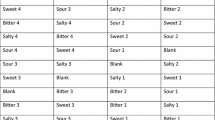Abstract
Although 5% of the general population exhibit a functional anosmia, little is known about the frequency of gustatory disorders. Whenever taste function has been tested within large sociodemographic studies, so far only short test versions were applied making the interpretation difficult. Using two psychophysical taste tests, the validated “taste strips” and suprathreshold taste solutions of the four basic tastes sweet, sour, salty and bitter we investigated 761 healthy subjects within the age range of 5–89 years. Prior to testing, all subjects rated their taste function. According to testing with the taste strips, 5.3% scored below the result considered as hypogeusia. All four taste sprays were correctly identified by 82.3% of all subjects. Results of the two taste tests correlated positively (r = 0.33, p < 0.001), and there was a significant negative correlation between age and test results. However, we never observed complete ageusia. Misinterpretations of tastes were surprisingly common. In summary, hypogeusia was present in 5% while complete ageusia seems to be very rare, in contrast to misinterpretations of tastes.


Similar content being viewed by others
References
Ahne G, Erras A, Hummel T, Kobal G (2000) Assessment of gustatory function by means of tasting tablets. Laryngoscope 110:1396–1401
Bramerson A, Johansson L, Ek L, Nordin S, Bende M (2004) Prevalence of olfactory dysfunction: the skovde population-based study. Laryngoscope 114:733–737
Cruickshanks KJ, Schubert CR, Snyder PJ, Bartoshuk LM, Huang GH, Klein BEK, Klein R, Nieto FJ, Pankow JS, Tweed TS, Krantz EM, Moy GS (2009) Measuring taste impairment in epidemiologic studies. The Beaver Dam offspring study. Ann N Y Acad Sci 1170:543–552
Damm M, Temmel A, Welge-Luessen A, Eckel HE, Kreft M-P, Klussmann JP, Gudziol H, Hüttenbrink K-B, Hummel T (2004) Epidemiologie und Therapie von Riechstörungen in Deutschland, Österrreich und der Schweiz. HNO 52:112–120
Deems DA, Doty RL, Settle G, Moore-Gillon V, Shaman P, Mester AF, Kimmelmann CP, Brightman VJ, Snow JBJ (1991) Smell and taste disorders, a study of 750 patients from the university of Pennsylvania smell and taste center. Arch Otolaryngol Head Neck Surg 117:519–528
Doty RL, Shaman P, Applebaum SL, Giberson R, Sikorsky L, Rosenberg L (1984) Smell identification ability: changes with age. Science 226:1441–1443
Fox AL (1931) Six in ten “tasteblind” to bitter chemical. Sci News Lett 9:249
Fukunaga A, Uematsu H, Sugimoto K (2005) Influences of aging on taste perception and oral samatic sensation. J Gerontol 60A:109–113
Gent JF, Goodspeed RB, Zagraniski RT, Catalanotto FA (1987) Taste and smell problems: validation of questions for the clinical history. Yale J Biol Med 60:27–35
Gudziol H, Hummel T (2007) Normative values for the assessment of gustatory function using liquid tastants. Acta Otolaryngol 127:658–661
Henkin RI, Gill JRJ, Bartter FC (1963) Studies on taste thresholds in normal man and in patients with adrenal cortical insufficiency: the role of adrenal cortical steroids and serum sodium concentration. J Clin Invest 42:727–735
Henkin RI, Shallenberger RS (1970) Aglycogeusia: the inabillty to recognize sweetness and its possible molecular basis. Nature 29:965–966
Huque T, Cowart BJ, Dankulich-Nagrudny L, Pribitkin EA, Bayley DL, Spielman AI, Feldman RS, Mackler SA, Brand JG (2009) Sour ageusia in two individuals implicates ion channels off the ASIC and PKD families in human sour taste perception at the anterior tongue. PLoS One 4:e7347–e7348
Landis BN, Hummel T, Hugentobler M, Giger R, Lacroix JS (2003) Ratings of overall olfactory function. Chem Senses 28:691–694
Landis BN, Konnerth CG, Hummel T (2004) A study on the frequency of olfactory dysfunction. Laryngoscope 114:1764–1769
Landis BN, Welge-Luessen A, Bramerson A, Bende M, Mueller CA, Nordin S, Hummel T (2009) “Taste-strips”—a rapid, lateralized gustatory bedside identification test based on impregnated filter papers. J Neurol 256:242–248
Lugaz O, Pillias A-M, Faurion A (2002) A new specific ageusia: some humans cannot taste l-glutamate. Chem Senses 27:105–115
Mueller C, Kallert S, Renner B, Stiassny K, Temmel AF, Hummel T, Kobal G (2003) Quantitative assessment of gustatory function in a clinical context using impregnated “taste-strips”. Rhinology 41:2–6
Murphy C, Schubert CR, Cruickshanks KJ, Klein BE, Klein R, Nondahl DM (2002) Prevalence of olfactory impairment in older adults. JAMA 288:2307–2312
Nordin S, Brämerson A, Bringlöv E, Kobal G, Hummel T, Bende M (2007) Substance and tongue-region specific loss in basic taste quality identification in elderly adults. Eur Arch Otorhinolaryngol 264:285–289
Pilková L, Nováková M, Pokorný J (1991) Naming and identification of tastes in aqueous solutions. Nahrung 9:999–1002
Pribitkin E, Rosenthal M, Cowart BJ (2003) Prevalence and causes of severe taste loss in a chemosensory clinic population. Ann Otol Rhinol Laryngol 112:971–978
Schiffman SS (1997) Taste and smell losses in normal aging and disease. JAMA 278:1357–1362
Schumm LP, McClintock M, Williams S, Leitsch S, Lundstrom J, Hummel T, Lindau ST (2009) Assessment of sensory function in the mational social life, health and aging project. J Gerontol Soc Sci 64 B:76–85
Shu CH, Hummel T, Lee PL, Chiu CH, Lin SH, Yuan BC (2009) The proportion of self-rated olfactory dysfunction does not change across the life span. Am J Rhinol Allergy 23:413–416
Soter A, Kim J, Jackman A, Tourbier I, Kaul A, Doty RL (2008) Accuracy of self-report in detecting taste dysfunction. Laryngoscope 118:611–617
Vennemann MM, Hummel T, Berger K (2008) The association between smoking and smell and taste impairment in the general population. J Neurol 255:1121–1126
Weiffenbach JM, Baum BJ, Burghauser R (1982) Taste thresholds: quality specific variation with human aging. J Gerontol 37:372–377
Yamauchi Y, Endo S, Sakai F, Yoshimura I (2002) A new whole-mouth gustatory test procedure. I. Thresholds and principal component analysis in healthy men and women. Acta Otolaryngol Suppl 546:39–48
Yamauchi Y, Endo S, Yoshimura H (2002) A new whole-mouth gustatory test procedure. II. Effects of aging, gender and smoking. Acta Otolaryngol Suppl 546:49–59
Author information
Authors and Affiliations
Corresponding author
Rights and permissions
About this article
Cite this article
Welge-Lüssen, A., Dörig, P., Wolfensberger, M. et al. A study about the frequency of taste disorders. J Neurol 258, 386–392 (2011). https://doi.org/10.1007/s00415-010-5763-5
Received:
Revised:
Accepted:
Published:
Issue Date:
DOI: https://doi.org/10.1007/s00415-010-5763-5




